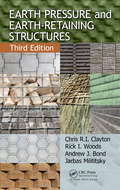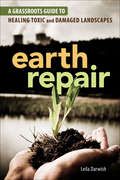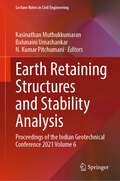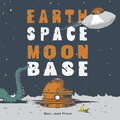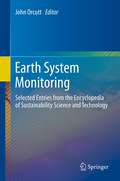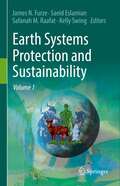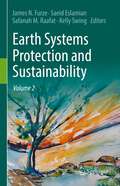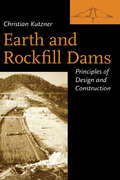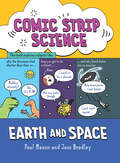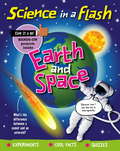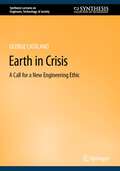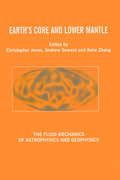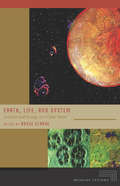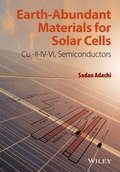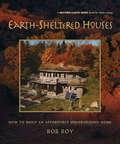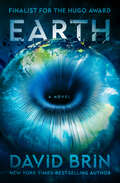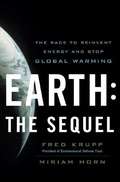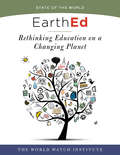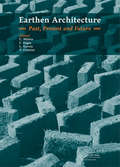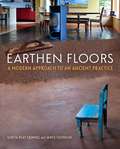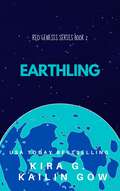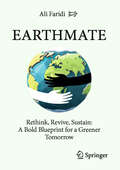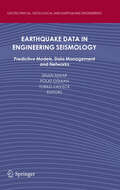- Table View
- List View
Earth Pressure and Earth-Retaining Structures
by Chris R.I. Clayton Rick I. Woods Jarbas MilititskyEffectively Calculate the Pressures of SoilWhen it comes to designing and constructing retaining structures that are safe and durable, understanding the interaction between soil and structure is at the foundation of it all. Laying down the groundwork for the non-specialists looking to gain an understanding of the background and issues surrounding g
Earth Repair: A Grassroots Guide to Healing Toxic and Damaged Landscapes
by Leila DarwishMillions of acres of land have been contaminated by pesticides, improperly handled chemicals, dirty energy projects, toxic waste, and other pollutants in the United States alone. This toxic legacy impacts the environment, our health, our watersheds, and land that could otherwise be used to grow healthy local food and medicines. Conventional clean-up techniques employed by government and industry are tremendously expensive and resource-intensive and can cause further damage. More and more communities find themselves increasingly unable to rely on those companies and governments who created the problems to step in and provide solutions.Earth Repair describes a host of powerful grassroots bioremediation techniques, including:Microbial remediation-using microorganisms to break down and bind contaminantsPhytoremediation-using plants to extract, bind, and transform toxinsMycoremediation-using fungi to clean up contaminated soil and waterPacked with valuable, firsthand information from visionaries in the field, Earth Repair empowers communities and individuals to take action and heal contaminated and damaged land. Encompassing everything from remediating and regenerating abandoned city lots for urban farmers and gardeners to recovering from environmental disasters and industrial catastrophes such as oil spills and nuclear fallout, this fertile toolbox is essential reading for anyone who wishes to transform environmental despair into constructive action.Leila Darwish is a community organizer, urban gardener, and permaculture designer with a focus on using grassroots bioremediation to address environmental justice issues in communities struggling with toxic contamination of their land and drinking water.
Earth Retaining Structures and Stability Analysis: Proceedings of the Indian Geotechnical Conference 2021 Volume 6 (Lecture Notes in Civil Engineering #303)
by Kasinathan Muthukkumaran Balunaini Umashankar N. Kumar PitchumaniThis book comprises the select peer-reviewed proceedings of the Indian Geotechnical Conference (IGC) 2021. The contents focus on Geotechnics for Infrastructure Development and Innovative Applications. This book covers topics geotechnical challenges in tunnel construction, related performance of temporary secant pile wall, soil nail walls, rock-fill embankment dams, performance of MSE wall, stability analysis, dynamic stability and landslide simulations, landslide early warning system, among others. This book is of interest to those in academia and industry. This book is of interest to those in academia and industry.
Earth Science for Civil and Environmental Engineers
by Richard E. JacksonThis carefully targeted and rigorous new textbook introduces engineering students to the fundamental principles of applied Earth science, highlighting how modern soil and rock mechanics, geomorphology, hydrogeology, seismology and environmental geochemistry affect geotechnical and environmental practice. Key geological topics of engineering relevance including soils and sediments, rocks, groundwater, and geologic hazards are presented in an accessible and engaging way. A broad range of international case studies add real-world context, and demonstrate practical applications in field and laboratory settings to guide site characterization. End-of-chapter problems are included for self-study and evaluation and supplementary online materials include electronic figures, additional examples, solutions, and guidance on useful software. Featuring a detailed glossary introducing key terminology, this text requires no prior geological training and is essential reading for senior undergraduate or graduate students in civil, geological, geotechnical and geoenvironmental engineering. It is also a useful reference and bridge for Earth science graduates embarking on engineering geology courses.
Earth Space Moon Base
by Ben Joel PriceOuter space, a moon base, and . . . bananas? Discover Ben Joel Price's quirky extraterrestrial world and its unusual trio of guardians. A spaceman, a robot, and a cheeky monkey use a most unusual method to protect Earth from hungry, googly-eyed moon aliens. Ben Joel Price's offbeat rhymes and colorful, retro-style illustrations evoke a funny little world away from ours, which will captivate readers young and old.
Earth System Monitoring
by John OrcuttModern Earth System Monitoring represents a fundamental change in the way scientists study the Earth System. In Oceanography, for the past two centuries, ships have provided the platforms for observing. Expeditions on the continents and Earth's poles are land-based analogues. Fundamental understanding of current systems, climate, natural hazards, and ecosystems has been greatly advanced. While these approaches have been remarkably successful, the need to establish measurements over time can only be made using Earth observations and observatories with exacting standards and continuous data. The 19 peer-reviewed contributions in this volume provide early insights into this emerging view of Earth in both space and time in which change is a critical component of our growing understanding.
Earth Systems Protection and Sustainability: Volume 1
by James N. Furze Kelly Swing Saeid Eslamian Safanah M. RaafatEarth Systems Protection and Sustainability qualifies imperatives and discusses the use of mathematical approaches to assess and achieve sustainability in threatened and vulnerable Earth systems globally. Mathematical advances in this context include both operational and Boolean methods, as well as linguistic, logic-based Bayesian approaches and generative mathematics relevant to scenario formation. The mathematic methods are refined into functional areas and deeper learning, which enable the use of searching algorithms to achieve optimal solutions for the circular nature and application of sustainability. Pertinent sections and synergistic elements are covered in order to synthesize key informative nodes, advising of the very real dangers facing planet Earth and its biodiversity. Each volume stands in its own right. Analytical and scientific chapters are blended with social resilience and socio-economic development consideration, thus enabling the settings of sustainability within varying scenarios of climatic forces and species dynamics.Volume 1 focuses on ground-breaking evolutionary expansion assisting with life’s continuation on Earth, sustainable management of pathogens and halophyte uses in agroecology, bioremediation methods in drilling waste management, conservation and sustainability of diversity, climate change mitigation strategies, displacement management in a large scale ongoing crisis, risk reduction and management policy, sustainably intelligent-driven markets, sustainability consensus in an uncertain environment and path planning in static and dynamic environments. Pictorial contributions made from across the world refine particularly urgent problems for attention, and provide solutions and methods of environmental sustainability operated in communities, complementing the descriptive chapter sections. Both volumes are targeted for a global audience of academic, professional, classroom, governmental, unit and community members, and seek to include all sectors to ensure ongoing and comprehensive Earth Systems Protection.
Earth Systems Protection and Sustainability: Volume 2
by James N. Furze Kelly Swing Saeid Eslamian Safanah M. RaafatEarth Systems Protection and Sustainability authorises imperatives to achieve sustainability and protect our threatened and vulnerable Earth. Mathematical advances in context incorporate operational and Boolean, as well as linguistic, logic-based Bayesian, and generative methods for scenario formation. Functional areas and deeper learning enable the use of searching algorithms, proffering optimal solutions for the circular nature of sustainability in natural ecosystems and human dominated settings. Key informative nodes are provided in the hope that we may moderate the very real dangers facing planet Earth and its biodiversity. An arena of insightful chapters is blended with social resilience and socio-economic development coverage, accentuating integrity, protection and sustainability within divergent climatic forces and species dynamics on Earth. Volume 2 focuses on bioaccumulation; climate change and resilience for co-operative socio-economic and ecosystem management via policy frameworks across sectors; mathematical modelling of freshwater in coastal regions in arid and semi-arid zones; decision making in natural disasters; peat solidification for environmentally sustainable geotechnical engineering; green energy conversion; flood risk mapping; rainfall analysis; exposure, safety, and security amidst increasing environmental contamination; remote handling vehicles; wind turbines; and deep learning and its environmental applications. Earth Systems Protection and Sustainability is addressed globally to communities, schools and researchers in professional, governmental and unit operations; descriptive and illustrative sections include all sectors to ensure Earth Systems Protection as our capacity reaches an unsustainable climax.
Earth and Rockfill Dams: Principles for Design and Construction
by Christian KutznerThis text methodically demonstrates the basic rules for the design criteria of earthfill and rockfill dams. It expertly guides the reader from preliminary work through the design of various embankment dams and on to the construction and finally the control of safety in completed structures.
Earth and Space (Comic Strip Science #2)
by Paul MasonFind out about the science behind the solar system, the big bang, gravity, black holes and much more with hilarous cartoon strips, facts and diagrams.Each spread in this series features a short, funny comic strip that explains a process or aspect of science. Around the strip, diagrams and panels give further information on the topic. They are a fantastic way to engage children aged 8 plus with science.The illustrator, Jess Bradey, is winner of the 2021 Blue Peter Award for Best Non-Fiction for A Day in the Life of a Poo, Gnu and You and also writes and draws for The Phoneix Comic. Titles in the series: Biology, Chemistry, Earth and Space, Physics.
Earth and Space (Science in a Flash #36)
by Georgia Amson-BradshawHelp kids discover science - in a flash!Learn about Earth and Space in this book for curious cosmic kids. Discover what's inside the sun, and what's outside the solar system. From mini-meteors to giant galaxies: the universe is within these pages!This essential KS2 series for children aged 7 and up covers all the key science topics in energetic, quick-fire way, aiding clear comprehension by getting straight to the point! Each spread starts with a 'flash' or headline, summing-up succinctly the science information to follow. Attractive and light-hearted illustration visually conveys the information, adding depth and detail to engage children. Also includes fun jokes and cartoons to keep even the most reluctant readers entertained.
Earth in Crisis: A Call for a New Engineering Ethic (Synthesis Lectures on Engineers, Technology, & Society #26)
by George CatalanoThis book examines the ethical responsibilities of engineers and scientists in light of new advances in science with a distinct reflection on quantum mechanics. This thorough coverage of these new advances will assist the reader in rethinking our place in the universe and broadening a sense of ethical responsibility for the planet. This book addresses an approach to integrating these changes and deal with issues such as global climate change and the sixth extinction. This book compares new ideas in engineering that extend ethical boundaries beyond our present understanding in which Engineering ethics is locked in the world view of the 18th and 19th centuries. This books coverage examines how our understanding of the world has changed due to developments in science and society to include green, humanitarian, social justice, and omnium approaches to the engineering profession. The coverage of societal and ethics in science and engineering practice are examined through four major areas. Green engineering is the design that promotes the use of processes and products that minimize pollution, promote sustainability, and protect human health without sacrificing economic viability and efficiency. Humanitarian engineering seeks to directly improve the well-being of poor, marginalized, or under-served communities, which often lack the means to address pressing problems. Engineering for social justice imagines a new kind of engineering firmly affixed to the common good. Finally, a new approach, omnium engineering, seeks to promote an engineering profession that considers the wants and needs of all life forms not only that of the human speciesThe scope of this treatise is to examine the premise that the earth is facing grave crises when confronting global climate change and the sixth extinction. Engineering may be the planet’s last best hope, but it requires a new ethic that takes a much broader view of the profession’s ethical responsibilities. Moreover, the engineering ethic is rooted in the science of the past (Newtonian mechanic). Science has changed (quantum mechanics) but the engineering world view has not. Embracing this new science will inevitably lead to a new story of our responsibilities towards the planet.
Earth's Core and Lower Mantle (The Fluid Mechanics of Astrophysics and Geophysics)
by Christopher A. Jones Keke Zhang Andrew M. SowardScientists have made new inroads in the study of the Earth's deep interior. They have forged developments in this fascinating arena using experimental and observational techniques,. including seismology, monitoring of the Earth's rotation, geomagnetism, and accurate measurements of Earth's gravity fields. These techniques along with more theoretica
Earth, Life, and System: Evolution and Ecology on a Gaian Planet (Meaning Systems)
by Bruce ClarkeExploring the broad implications of evolutionary theorist Lynn Margulis’s work, this collection brings together specialists across a range of disciplines, from paleontology, molecular biology, evolutionary theory, and geobiology to developmental systems theory, archaeology, history of science, cultural science studies, and literature and science. Addressing the multiple themes that animated Margulis’s science, the essays within take up, variously, astrobiology and the origin of life, ecology and symbiosis from the microbial to the planetary scale, the coupled interactions of earthly environments and evolving life in Gaia theory and earth system science, and the connections of these newer scientific ideas to cultural and creative productions. Dorion Sagan acquaints the reader with salient issues in Lynn Margulis’s scientific work, the controversies they raised, and the vocabulary necessary to follow the arguments. Sankar Chatterjee synthesizes several strands of current theory for the origin of life on earth. James Strick tells the intertwined origin stories of James Lovelock’s Gaia hypothesis and Margulis’s serial endosymbiosis theory. Jan Sapp explores the distinct phylogenetic visions of Margulis and Carl Woese. Susan Squier examines the epigenetics of embryologist and developmental biologist C. H. Waddington. Bruce Clarke studies the convergence of ecosystem ecology, systems theory, and science fiction between the 1960s and the 1980s. James Shapiro discusses the genome evolution that results not from random changes but rather from active cell processes. Susan Oyama shows how the concept of development balances an over-emphasis on genetic coding and other deterministic schemas. Christopher Witmore studies the ways in which a concentrated animal feeding operation, or CAFO, mixes up natural resources, animal lives, and human appetites. And Peter Westbroek brings the insights of earth system science toward a new worldview essential for a proper response to global change.
Earth-Abundant Materials for Solar Cells
by Sadao AdachiSystematically describes the physical and materials properties of copper-based quaternary chalcogenide semiconductor materials, enabling their potential for photovoltaic device applications.Intended for scientists and engineers, in particular, in the fields of multinary semiconductor physics and a variety of photovoltaic and optoelectronic devices.
Earth-Sheltered Houses
by Rob RoyAn earth-sheltered, earth-roofed home has the least impact upon the land of all housing styles, leaving almost zero footprint on the planet. Earth-Sheltered Houses is a practical guide for those who want to build their own underground home at moderate cost. It describes the benefits of sheltering a home with earth, including the added comfort and energy efficiency from the moderating influence of the earth on the home's temperature (keeping it warm in the winter and cool in the summer), along with the benefits of low maintenance and the protection against fire, sound, earthquake, and storm afforded by the earth. Extra benefits from adding an earth or other living roof option include greater longevity of the roof substrate, fine aesthetics, and environmental harmony.The book covers all of the various construction techniques involved, including details on planning, excavation, footings, floor, walls, framing, roofing, waterproofing, insulation, and drainage. Specific methods appropriate for the inexperienced owner/builder are a particular focus and include: Pouring one's own footings and/or floor The use of dry-stacked (surface-bonded) concrete block walls Post-and-beam framing Plank-and-beam roofing Drainage methods and self-adhesive waterproofing membranes The time-tested, easy-to-learn construction techniques described in Earth-Sheltered Houses will enable readers to embark upon their own building projects with confidence, backed up by a comprehensive resources section that lists all the latest products such as waterproofing membranes, types of rigid insulation, and drainage products that will protect the building against water damage and heat loss. Rob Roy is a former contractor with 27 years of experience and 12 previous books to his credit, including Cordwood Building and Timber Framing for the Rest of Us. An expert on underground building, he founded the Earthwood Building School in 1981 with his wife, Jaki, and is frequently a speaker at events throughout North America.
Earth: A Novel
by David BrinIn this classic hard science fiction-thriller by the New York Times–bestselling author of Startide Rising, a man-made black hole threatens the future of Earth. Scientist Alex Lustig has created a tiny, yet very destructive, problem—a microscopic black hole that he accidentally dropped into Earth&’s core. Now, racing to keep it from consuming the planet, he begins to suspect something even stranger is going on. Something linked to civilization&’s expanding information web. And with the planet overpopulated and neglect taking its toll on the environment, there are those who demand a harsh solution: that Mother Earth would be better off without humanity at all . . . A Finalist for the Hugo Award for Best Novel&“The Moby-Dick of the whole Earth movement.&” —Locus &“A powerful, cautionary tale.&” —San Francisco Chronicle &“Brin has conceived his story on a supremely ambitious scale, and executed it with all of the skills at his command.&” —Chicago Sun-Times &“It is indeed a book that anyone interested in the survival of our terrifying species should read.&” —Interzone
Earth: The Race to Reinvent Energy and Stop Global Warming
by Fred Krupp Miriam HornHOW TO HARNESS THE GREAT FORCES OF CAPITALISM TO SAVE THE WORLD FROM CATASTROPHE. The forecasts are grim and time is running out, but that's not the end of the story. In this book, Fred Krupp, longtime president of Environmental Defense Fund, brings a stirring and hopeful call to arms: We can solve global warming. And in doing so, we will build the new industries, jobs, and fortunes of the twenty-first century. In these pages the reader will encounter the bold innovators and investors who are reinventing energy and the ways we use it. Among them: a frontier impresario who keeps his ice hotel frozen all summer long with the energy of hot springs; a utility engineer who feeds smokestack gases from coal-fired plants to voracious algae, then turns them into fuel; and a tribe of Native Americans, for two thousand years fishermen in the roughest Pacific waters, who are now harvesting the fierce power of the waves themselves. These entrepreneurs are poised to remake the world's biggest business and save the planet-if America's political leaders give them a fair chance to compete.
EarthEd: Rethinking Education on a Changing Planet (State of the World)
by The Worldwatch InstituteEarth education is traditionally confined to specific topics: ecoliteracy, outdoor education, environmental science. But in the coming century, on track to be the warmest in human history, every aspect of human life will be affected by our changing planet. Emerging diseases, food shortages, drought, and waterlogged cities are just some of the unprecedented challenges that today's students will face. How do we prepare 9.5 billion people for life in the Anthropocene, to thrive in this uncharted and more chaotic future?Answers are being developed in universities, preschools, professional schools, and even prisons around the world. In the latest volume of State of the World, a diverse group of education experts share innovative approaches to teaching and learning in a new era. Topics include systems thinking for kids; the importance of play in early education; social emotional learning; comprehensive sexuality education; indigenous knowledge; sustainable business; medical training to treat the whole person; teaching law in the Anthropocene; and more.EarthEd addresses schooling at all levels of development, from preschool to professional. Its lessons can inform teachers, policy makers, school administrators, community leaders, parents, and students alike. And its vision will inspire anyone who wants to prepare students not only for the storms ahead but to become the next generation of sustainability leaders.
Earthen Architecture: Past, Present and Future
by C. Mileto V. Cristini L. García SorianoEarthen architecture is widespread all over the world and demonstrates a significant richness of varieties both in application and in materials used. This book discusses and debates the lessons that can be learned from earthen architecture to create sustainable architecture today, both for the conservation of traditional existing buildings and the
Earthen Floors
by James Thomson Sukita Reay CrimmelFor most of human history, people have lived in durable, comfortable buildings made from natural materials such as soil, sand, rocks, and fiber. All over the globe, these ancient traditions persist; a quarter to a third of the world's population today lives in houses built partially or entirely of earth. Conventional Western building techniques using industrial materials may save time and create efficiencies, but these perceived savings come at considerable financial and environmental cost.As well as boasting a unique and beautiful aesthetic, natural building techniques are accessible, affordable, and non-toxic. Earthen Floors: A Modern Approach to an Ancient Practice is the first comprehensive, fully illustrated manual covering the history, use, and maintenance of this attractive, practical flooring option. This detailed, fully illustrated guide explains every part of the process, including: Sourcing and harvesting materials Preparing the subfloor Pouring, finishing, and sealing the floor Living with and maintaining your earthen floorBecause information on creating quality earthen floors was not previously widely available, there have been some negative experiences. Drawing on the combined knowledge of the most qualified earthen floor practitioners, as well their own substantial experience, the authors deliver the definitive resource for this exciting technique, perfect for everyone from the novice to veteran builder.Sukita Reay Crimmel has installed over twenty thousand square feet of earthen flooring, and is one of the preeminent experts in the emerging field of earthen floors.James Thomson is part of House Alive, one of the leading natural building training organizations in the country.
Earthling (Red Genesis #2)
by Kailin Gow Kira G.Book 2 of the Red Genesis Series... What if the last Earthlings on New Earth was worst than the Monsters who destroyed Old Earth? USA Today Bestselling and ALA YALSA Award-winning Authors Kira G. and Kailin Gow's Science Fiction Post-Apocalypse Thriller. If you liked Bird Box and The Quiet Place, you will enjoy RED GENESIS. Evie discovered she was not the only one left on New Earth, and that the other humans may be worst than the Monsters that destroyed Earth. As she tries to salvage what remains of the Red Genesis, she finds the answers to what may save Earth in something tied to her past. This is a STEM/ELA Literary Book for Age 14 and Up and includes STEM and ELA Literary Discussion Questions.
Earthmate: Rethink, Revive, Sustain: A Bold Blueprint for a Greener Tomorrow
by Ali Faridi MasoulehIn EARTHMATE, discover a comprehensive and scientifically grounded approach to sustainability, offering practical solutions for navigating the challenges of a rapidly changing world. This book is not just an exploration of Earth’s ecosystems, but a roadmap for how we can live in harmony with nature, ensuring a thriving planet for generations to come. Explore the intricate web of connections that sustain life on Earth, from the smallest microorganisms to the largest ecosystems. Through evidence-based insights and cutting-edge research, the book provides a deeper understanding of the environmental challenges we face today—and how we can mitigate their impact. Packed with practical advice, EARTHMATE empowers individuals, communities, and organizations to implement sustainable practices in everyday life. From energy conservation to sustainable agriculture, the book translates complex scientific concepts into actionable steps that can drive meaningful change. In a world where climate change and environmental degradation are pressing concerns, it emphasizes the importance of collective action. It inspires readers from all walks of life—scientists, policymakers, educators, activists, and global citizens—to join the movement for a sustainable future. Whether you’re an environmental professional seeking to expand your knowledge, or a curious reader eager to learn how your choices can shape a sustainable future, this guide provides the knowledge, tools, and inspiration to make a tangible difference. EARTHMATE is a compelling call to action, offering not only the scientific foundations of sustainability but also a vision for how we can rebuild our relationship with the natural world. Through informed decision-making and conscious living, we can all become true Earthmates.
Earthquake Data in Engineering Seismology
by Polat Gülkan Sinan Akkar Torild Van EckThis book addresses current activities in strong-motion networks around the globe, covering issues related to designing, maintaining and disseminating information from these arrays. The book is divided into three principal sections. The first section includes recent developments in regional and global ground-motion predictive models. It presents discussions on the similarities and differences of ground motion estimations from these models and their application to design spectra as well as other novel procedures for predicting engineering parameters in seismic regions with sparse data. The second section introduces topics about the particular methodologies being implemented in the recently established global and regional strong-motion databanks in Europe to maintain and disseminate the archived accelerometric data. The final section describes major strong-motion arrays around the world and their historical developments. The last three chapters of this section introduce projects carried out within the context of arrays deployed for seismic risk studies in metropolitan areas. Audience: This timely book will be of particular interest for researchers who use accelerometric data extensively to conduct studies in earthquake engineering and engineering seismology.
